by Winding Pathways | Sep 7, 2023 | (Sub)Urban Homesteading, Chickens, Garden/Yard
What’s Egg Color Got to Do With It?
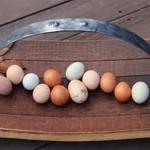
An array of jewels. Photo by Lisa Ramlo.
Are brown-shelled eggs better than white-shelled ones? Supermarkets sell all sorts of eggs. Brown or white shell. Free range or not. Organic. Vegan. Prices per dozen vary greatly. How is a consumer supposed to buy the freshest and tastiest egg?
We’ve been raising chickens for decades and have kept hens that lay white, brown, and even blue and green-shelled eggs. All are laid by birds of the very same species. The nutritional value of an egg is the same no matter what its shell color. Taste varies depending on how fresh the egg is and what the hen ate. It is independent of shell color.
Brown Eggs: Most supermarket brown eggs are laid by hybrid hens, often called ISA Browns. These were developed from the somewhat large Rhode Island Red breed. They may be raised in cages in enormous factory farms or come from a smaller free-range flock. Brown-shelled eggs may be free-range or organic……or not.
White Eggs: Almost all supermarket white eggs are laid by White Leghorn hybrids. They are smaller-bodied hens than brown egg layers and are commonly raised in cages in enormous chicken factory farms.
Blue or Green Eggs: Rarely seen in supermarkets, these beautiful eggs are laid by the Araucana breed or hybrids developed from them. These hens are common in backyard flocks.
Organic: If labeled organic the hens are supposed to have been fed feed raised according to organic standards. Eggs marked vegan or natural may or may not be organic. Be wary of vegan eggs, as hens are omnivores. If they encounter insects, worms or meat scraps they’ll readily devour them.
Cage Free: The hens that laid these eggs normally are crammed into a large building but are not confined to the tight space of a cage. They may, or may not, have access to the outdoors.
Free Range: This is tricky. Supposedly free-range hens have ready access to the outdoors, but there may be only a tiny outdoor run for thousands of hens to enjoy.
How To Tell If Eggs Are Fresh

Store-bought eggs are a pale yellow with runny whites. Fresh eggs radiate a golden hue centered in a firm albumen.
Nearly all egg cartons claim that the eggs inside are fresh, but what does that mean? They could have been laid six weeks earlier. To tell if an egg is fresh, fill a deep bowl with water and gently put an egg on the surface. If it sinks it’s reasonably fresh. If it floats it’s old. The reason is, a fresh egg has a small air cell. As it ages, moisture leaves through the porous shell and the air cell grows, making the egg buoyant.
The white, or albumen, of a fresh egg, will be relatively deep when cracked into the frying pan. It will spread out widely and be flat in an old egg.
How to Tell if Hens are Truly Pastured Raised
Most commercial eggs come from hens fed a specially prepared diet that provides all the nutrients they need but little else. The eggs will have pale yolks. In contrast eggs laid by hens with ready access to green vegetation will lay eggs with deep orange or yellow yolks. Some premium chicken feeds include marigold petals that impart deep color to the yolks.
Choosing the Highest Quality Eggs
It may take buying several dozen differently marketed eggs to find the freshest, tastiest, and most attractive eggs. Although the least expensive eggs usually come from factory farms, the best eggs aren’t always the most expensive. The very best will be fresh and have a boldly colored yolk.
For information on chicken breeds scan the Hoover’s Hatchery Website . For general information on eggs and recipes check out the website of the Egg Industry Center.
by Winding Pathways | Aug 24, 2023 | (Sub)Urban Homesteading, Garden/Yard
Curious?
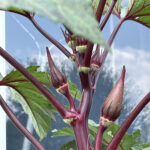
Pods about ready to harvest.
Well, although some websites suggest that, we don’t know. But, now that you are reading, keep on to learn the verified benefits of this unusual fruit eaten most often as a vegetable. One thing is for sure, it LOVES heat!
Okra is delicious.
Eaten raw just off the plant or carried into the house to mix with steamed or sauteed vegetables we enjoy it. A late summer joy is bringing a bowl of okra pods into the kitchen along with tomatoes, string beans, and chard. Too few backyard gardeners grow okra and most people, at least in northern states, rarely eat it.
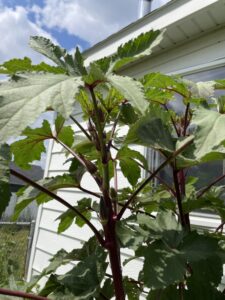
Botanically, Okra is a fruit.
Okra originated in Africa and loves rich soil and hot weather. It’s a tall plant that produces gorgeous blooms that quickly become slender pods. We pick the pods when they’re just a few inches long and often cut them in sections, dip the pieces in egg and cornmeal and lightly fry them. Yummy.

Mucilage helps make gumbo gumbo!
Okra is high in fiber, folate, antioxidants, Vitamins A and C. The “slime” many associate with okra is actually mucilage which is helpful in digestion. And, it is the “slime” that makes gumbo, gumbo!
Warning
Okra pods grow at an astonishing rate. If we forget to pick them for a few days they grow to six or eight inches long and are woody and inedible. Pick ‘em young and small.
Cookbooks featuring southern cuisine offer many recipes for this vegetable popular south of the Mason-Dixon line but too often ignored up north.
Preserving for the Next Season
Every late summer we let a few pods grow to full size. About the first frost we clip them off, let them thoroughly dry, and remove the seeds for planting next spring.
by Winding Pathways | Jun 8, 2023 | Garden/Yard, Nature, Pests
A “Hard Knock Life”
A tick’s life is hard. I’m hungry. I am a tick and I’ve been waiting a week for a juicy raccoon, dog, or wild turkey to walk by. Even a mouse would be welcome.
So far, no luck. I know a tick’s best bet for grabbing a passing animal is the “questing” position, so I’ve been hanging on to a branch with both pairs of my hind legs. My front pair of legs sticks out into the path ready to grab the fur or feathers of a passing animal. So far, no animal. Patience is hard and I’m hungry.
Larval Luck
I was luckier last year when I was a larva. I was hungry then, too, but the wait was short. A big, furry animal humans call a dog ambled by. Even though I only had six legs then I was able to grab a hold, and the rest was easy. I crawled around exploring under the fur until I found a spot with soft thin skin, dug in, and chowed down. Boy was that blood tasty! It was so nutritious that I left my host to grow and graduate. I’m now a tick nymph, complete with eight legs, but I need more blood to transform into an adult.
I’m still hungry. As I sit waiting, I admire the mosquitoes and flies that buzz by over my perch. They don’t need to be patient but can fly and search for a blood-rich victim. I can’t fly or jump, so all I can do is patiently wait until something walks by. I hope that’s soon because many of my fellow ticks starve.
Attracted to Carbon Dioxide and Moisture
What’s this? I sense a bubble of carbon dioxide and moisture. Might be the breath of an animal. Now I feel the vibration of footsteps. Must be a big animal. My front legs are outstretched in anticipation and I’m not disappointed.
I grab hold of a strange animal. It’s tall with only two legs. No hair. No feathers. Just some sort of covering over thin skin. No chance of biting through it, but I got a good grip on that covering and started climbing using all of my eight legs. Soon I was under what humans call pants and kept exploring and climbing. Bingo, I found a nice moist spot where my blood dinner was just beneath thin skin. I got ready to feast.
Then something happened. I should be happy with a meal so close at hand. Instead, I felt sick. My legs wouldn’t hold on and I dropped to the ground lifeless.
About Ticks
Pity the poor tick the above. Well, maybe not. It’s hard to pity an animal that can spread disease and discomfort. Ticks usually feed on mammals, birds, and even reptiles but if none come around, human blood suits them just fine.
Ticks are effective disease spreaders because of their relatively long life which can extend for two or three years and their habit of eating a blood meal during different life stages. This enables them to bite one animal carrying a disease in its blood and inject it into a different animal during a later feeding.
Seriously Avoiding Ticks
At Winding Pathways, we take ticks seriously. Rich has had Lyme disease twice, fortunately successfully cured by strong antibiotics. Other people are not as lucky and experience long-term symptoms. And, Lyme is not the only disease ticks spread.
Understanding ticks and taking precautions reduces the odds a person will be bitten and contract a disease from them.
How ticks Operate
Ticks are ambush hunters. As the tick describes above, they wait for a victim to pass within grabbing distance of their front legs. Often ticks walk around on their victim for several hours before they dig through the skin and help themselves to a blood meal.
In order to contract a tick-borne disease a victim must be bitten, so a walking tick won’t transmit illness.
Reduce Your Odds
We often explore the woods, work in our yard and garden, and generally spend time in tick country. Here are precautions we take that reduce the odds of a tick bite:
- We spray our outdoor clothes and shoes with permethrin. It lasts for several washings and kills ticks. The hapless tick described above fell victim to this chemical.
- We often tuck our pants legs into our socks, sprayed with permethrin, to make it hard for any tick that gets on our socks or pants to get under them.
- After returning to the house, we disrobe and shower after we have checked for ticks. They prefer moist dark body areas so we especially check those places. Clothing goes into the washer.
- We watch for symptoms of Lyme Disease, especially a rash and fatigue. If they appear we call our physician immediately.
Promising Product
A few years ago, Rich was so determined to prevent another Lyme Disease incident that he invested in socks, pants, and shirts from Insect Shield. The company infuses its clothing with permethrin that, they claim, is effective for at least 70 washings.
Does this chemical work? Is Insect Shield clothing worth buying? Well, since wearing it Rich hasn’t found a tick on him and he’s been free of Lyme Disease. That’s not a scientific verdict but it’s good enough for him to keep wearing the clothes.
-
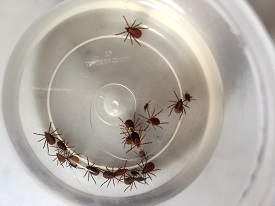
-
Tiny ticks can cause problems, so we go prepared in nature.
-

-
Pants, boots, varied sprays can reduce odds of picking up ticks
-
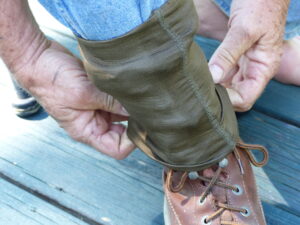
-
gaiters with tick guard helps repel ticks.
-
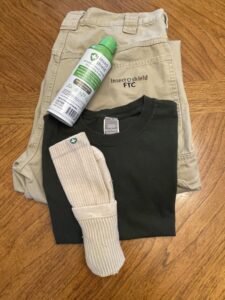
-
Pants, shirts, and socks infused with permethrin appear to keep ticks off.
Disclaimer
Rich purchased his Insect Shield clothing at the retail price. He’s still testing them but they seem to work. Winding Pathways was not paid for this blog.
by Winding Pathways | Apr 20, 2023 | (Sub)Urban Homesteading, Garden/Yard, Garden/Yard
People make a “to-do” about moles. They might be the most disliked animal in suburbia. We have them at Winding Pathways and are sharing tips on what we do about them.
Human Created Problems
Suburban and urban soil has a common problem. It is too often compacted. Construction companies often scrape topsoil off a yard before building a house. Then, they drive vehicles in the yard. When a family moves in, they soon create a dog run, drive their cars on the grass, and play on the lawn. Too many footsteps by pooches or people compact the ground.
Nature Has Solutions
Lawn plants struggle to thrive in tight soil, but nature has a remedy. Fossorial animals live in the soil and include moles, gophers, shrews, ants, worms, and others. Their burrowing constantly mixes and softens the dirt they live in, making it easier for plants to live.
Moles or Gophers?
People often confuse moles with gophers, but it’s easy to tell them apart. Moles prefer living in moist shady places and are at home in suburbia. They eat grubs and worms. Gophers, in contrast, are more likely to live in rural sunny pastures with dry soil and mostly eat roots. Mole hills are symmetrical, like mini volcano cones. Gophers, in contrast, make elliptical hills.
What Do You Really Value?
Ironically, most people who trap or poison moles profess to love a rich, green, “healthy” lawn, ignoring that nature loves diversity, not monocultures. Moles help make healthy lawns happen. Granted their hills of dirt and heaped linear tunnels can be unsightly and catch lawn mower blades.
Here is what we do at Winding Pathways:
- Thank our moles for helping make the soil soft and fertile.
- Rake out their hills before mowing.
- Stomp down their raised tunnels so our lawn mower does not catch on them.
- Enjoy the diversity of life in our yard.
Moles are as fascinating and beneficial as the butterflies that pollinate blooms or the cardinals who pluck seeds from feeders. They deserve respect for their valuable work.
-
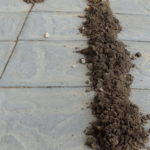
-
Moles bring rich dirt from below to the surface as they tunnel along hunting for earthworms and grubs.
-
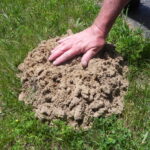
-
Moles sometimes push up excess dirt.
-
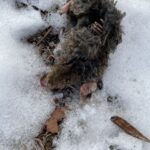
-
Moles’ feet are made for clearing dirt away.
by Winding Pathways | Feb 9, 2023 | (Sub)Urban Homesteading, Garden/Yard, Nature, Wonderment
“Yes,” to Geese If You Please
Guest blog by Jody Vrieze
When we lived in Plymouth, Iowa, my husband and I realized there is more to a home than just a house. We embraced our love of nature and animals by creating a retreat in our yard featuring natural diversity and beauty. Our outdoor spaces incorporated annual and perennial flowers, bird feeders, chickens, and Sebastopol geese.
Stay-cations vs. Vacations
A backyard pond featured aquatic plants, and different fish like koi, shubunkin, and goldfish. Raised bed gardens and beekeeping gave us additional duties and joy to enhance our little piece of heaven. Every season brought new activities and treasures. We found that we much prefer quiet stay-cations over vacations!
Perhaps the Sebastopol geese were among my favorites. I would call them by simply saying, “Hi peep peeps!”. They’d be running and following me everywhere. Even as I kayaked! Amazing creatures.❤️
Finding Our Inner Geese Love
Their names are Winston, Willow, and Aspen. When you watch the videos, Winston is always in the lead and Aspen is the smooth-feathered goose. At a poultry swap, we dickered with a man over a pair of Sebastopol geese. We walked away and returned. By then the goose had laid an egg. My husband asked if we could buy that egg and the seller replied, “No, but you can have it.”. The man asked if we wanted the pair of geese we’d dickered about to which my husband replied, “Nope, we have an egg!” We bought pizza, and while eating I cradled the egg to keep it warm. We went right out and bought an incubator. After many adventures of incubator lessons – the right temperature, unplugged or not, and against all odds – on Mother’s Day Lucy hatched.
Winston, Lucy, and Aspen
Winston was added to keep Lucy company. After losing Lucy, a lady brought an egg from a gal in Nebraska to add to the “family”. Even more adventures awaited us with geese. One goose broke her leg and I used our koi pond for rehabilitation.
Winston, the goose, tragically lost several mates and lived to be five or so years old before meeting his demise.
Moving On and Planning Ahead
We have since moved and I’m looking forward to a new coop and some new chickens.
After I was asked to share our adventures for the Winding Pathways blogs, I found that I loved going back through the photos and videos and watching the fun we had.
Now in our new location, we recently had a pair of swans and their cygnet land in our field. They came one morning but are gone now. They must have been planning to hunker down for an impending January snowstorm.
-
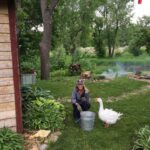
-
What fun to interact with the geese!
-

-
Jody rehabilitated an injured goose in her koi pond.
-

-
The geese flock around Jody in the stream.
by Winding Pathways | Jan 5, 2023 | (Sub)Urban Homesteading, Garden/Yard, Nature, Trees/Shrubs, Weeds
A raging blizzard roaring over Winding Pathways just before Christmas showed us the power of HARVESTING SNOW. We love catching it.
Well, we didn’t really catch the snow, but our prairie did. It has a talent for harvesting snow and other forms of moisture. It taught us how prairie and other taller plants – grasses, forbs, shrubs, vines, and trees – help themselves grow next summer.
Our prairie has a thick growth of two-foot-tall dead stems from last summer’s growth. Each stalk is brittle, but thousands of them working together slowed the wind just enough for it to drop the snow it had swept off nearby lawns and roads.
The deep drift that settled on our prairie will melt and give next spring’s plants a jumpstart in moist soil. Nearby shortly sheared lawns can’t catch snow and will start the spring on dryer soil. Nature delivered irrigation water to our yard for free!
Nature’s Wisdom in Harvesting Snow
Growing up in the East, we are used to Nor ‘easters that pummel the landscape and create great skiing conditions. Until we moved west, we were not so familiar with how nature replenishes soil moisture, well, naturally!
In dry areas snow also helps next summer’s vegetables. During college, Rich worked weekends at an Idaho ranch. He was surprised one January when Lucille Pratt, part owner of the land and an outstanding vegetable gardener, asked him to shovel snow from a nearby drift onto the garden.
For a Jersey boy, this seemed like a weird request, but melting snow oozed water into the soil. That helped get the vegetables going and sustain them through the dry summer.
Snow may seem like a bother but it’s also a blessing to dry soil and the plants it sustains.
Over two blizzardy days, our prairie gently caught snowflake after snowflake. We already are looking forward to bright prairie flowers dancing in next summer’s breeze. Thanks, prairie for harvesting snow. Nature’s wisdom to catch winter’s snow and help next summer’s growth is amazing.
-
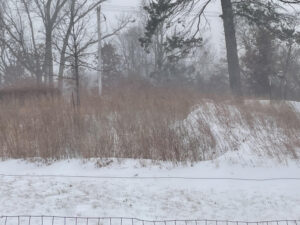
-
Capturing snow.
-
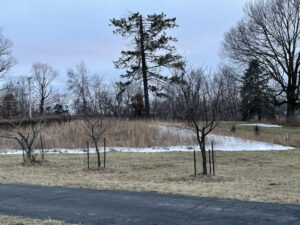
-
Three days later, a rapid melt left the ground bare, except where prairie plants held snow.

















